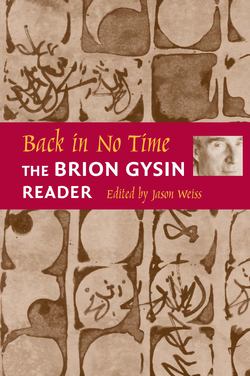Читать книгу Back in No Time - Brion Gysin - Страница 6
На сайте Литреса книга снята с продажи.
ОглавлениеPreface
This book began—a decade after Brion Gysin’s death—as the result of occasional discussions with friends I knew by way of him. I came to realize there was a certain quantity of rare or unpublished writings by Gysin, at the same time as I noticed that all of his published work was going out of print. This vanishing body of evidence, literarily speaking, sparked an idea that soon would not let me go.
I thought, at any rate, that it would be a project for me to do on the side—pull down the old books from my shelf and chase down a few texts in libraries or by word of mouth. It became, rather, a more involving project, which resembled a feverish sort of detective work: finding my way amid diverse paths and, with patience, catching the lepidoptera. The way things were going, it seemed to me, this might well be the only book available of Gysin for some time. I had to gather as much as I could, therefore, and then see what fit, taking full advantage of the publisher’s interest so as to offer the greatest range.
Ultimately, Gysin was a storyteller and a poet too, but he wrote in many different forms. How was I to make a coherent order of the many pieces except by chronology? And even there, a strict rule had to be bent a little, precisely for the sake of coherence (grouping the Permutation Poems or the Songs together). We can thus see the course of his written production over five decades, and perhaps glimpse some measure of the life lived.
Another way to divide the book is in two parts: half comprising the long excerpts from his historical narrative and his two novels; the other half made up of some forty pieces. Instead, I shuffled the decks and was back at chronology. The little pieces alongside the large—that indeed is a writer’s life. Any other system to classify these writings would be to set up needless obstacles in approaching them.
In selecting excerpts from the longer works, I sought to give a sense of the whole (beginnings, ends, important passages along the way) but also to highlight the strongest writing. I had to consider as well what sections might stand more or less on their own. For the historical narrative, To Master—A Long Goodnight, I have provided a brief overview of events in the parts of the text that I left out, but for the two complicated novels (and his screenplay of Naked Lunch) such summaries would have proved both cumbersome and unnecessary. Choosing the shorter pieces, on the other hand, was relatively easy: many, like the cut-ups and permutations, were particularly significant in Gysin’s career; others, more occasional pieces, reflect his varied activities and interests, or serve to illustrate certain turns in his thinking, or else they are simply curious and amusing. In the end, I think there may be some pleasant surprises for even the most ardent Gysin fans.
I would like to thank the following individuals who have helped with their suggestions, assistance and overall support in drawing together the materials for this anthology: Marie-Odile Briot and Gladys Fabre of the Musée d’Art Moderne de la Ville de Paris, Ira Cohen, Graham Dawes, Steve Lacy, Ramuntcho Matta, John Geiger, James Grauerholz, José Férez Kuri, Guillaume Gallozzi, Terry Wilson, Bernard Heidsieck, Suzanna Tamminen, Timothy Murphy, Pierre Joris, Maura High, Julie Allred, Udo Breger, Theo Green, Linda Norton, Katherine Fausset, Jennie Skerl, Richard Aaron, Séamas McSwiney, Ali Alizadeh, Carol Moore and Marilyn Wurzburger at Arizona State University Library’s Special Collections, Tara Wenger at the University of Texas’ Harry Ransom Humanities Research Center, L. Rebecca Johnson Melvin at the University of Delaware Library’s Special Collections, Ulrik Trojaborg and Annelise Ream at the Keith Haring Foundation, and Chris Chapman of Honeybee Robotics.
